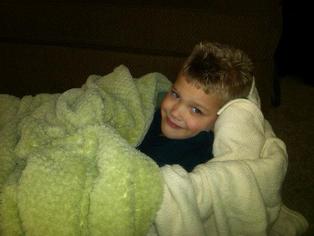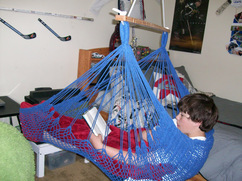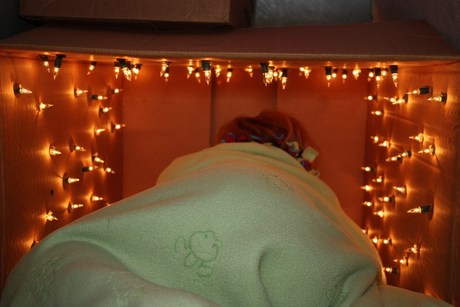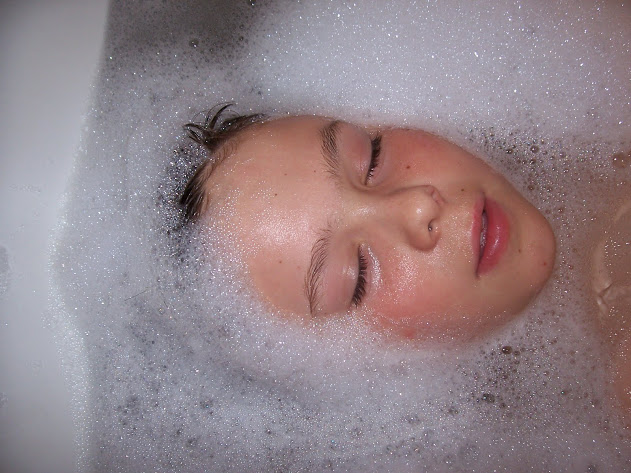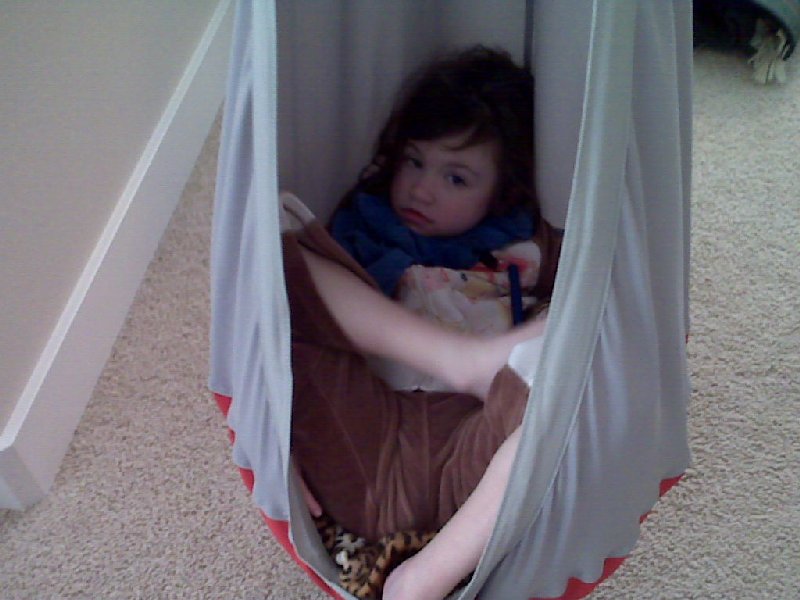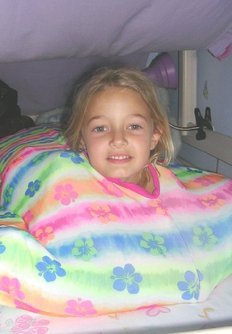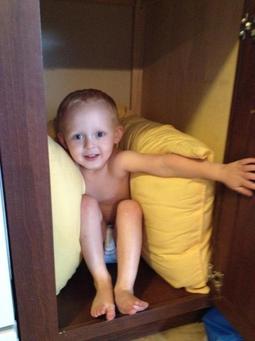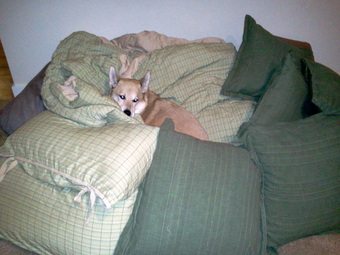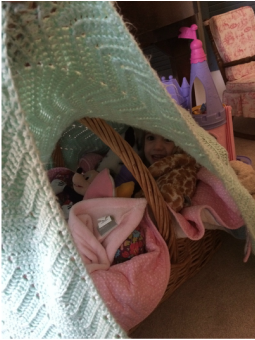A Sensory Retreat...An Essential Tool for All Children
A sensory retreat, which I recommend many times in Understanding Your Child's Sensory Signals, is a crucial component of a sensory home program and as a sensory tool for ALL children. A sensory retreat is especially helpful for children who over-register sensory input and demonstrate sensory defensiveness. It is also helpful for those who struggle with sensory modulation.
Key Components of a Sensory Retreat:
Sensory Retreat Ideas!
Pillow caves and squish boxes...
These are two ideas I came up with using household items since over the years, recommending expensive items from the therapy catalogs just wasn't feasible for most families. And me myself being a deep rooted "always want to get a good deal and clearance shopper", it was very fulfilling to me to come up with an idea that worked and was inexpensive! I did name the "pillow cave", but the squish box was already named in the therapy catalogs. You indeed can buy a fancy and cute squish box if you feel like it, they are out there.
HOW TO MAKE A PILLOW CAVE
MATERIALS NEEDED:
1. A twin size duvet cover (not any bigger) or two twin sheets sewn together leaving one of the short ends open. A body sock can also serve as a mini pillow cave.
2. Lots of throw pillows, blankets, stuffed animals, etc
The key to making the pillow cave is to be sure it is STUFFED, you then simply fluff it up in the corner of a room and your sensory kiddo can climb in it, on top of it and get cozy in it like a nest, they can go under it for some deep pressure and weight, or it can be used as a landing pad! It is also fun to add some sensory tools inside (for when it is not being jumped on) such as a flashlight, oral sensory tools, a vibrating pillow or toy, fidget toys, etc. (Or a dog) hehe
Key Components of a Sensory Retreat:
- Decreased sensory input overall
- A calm, quiet, low light setting
- Deep pressure touch and proprioception (achieved via the cozy small space)
- Soothing sensory tools, specific to the child's sensory needs
- Assists in self-regulation and helping a child in "fight or flight" recover and return to ready state.
- A therapeutic place for a child to recover from or avoid a sensory meltdown.
- A great place for much needed proprioception and full body deep pressure touch.
- A safe place to be removed from overwhelming sensory stimuli such as sound, light, touch, and movement.
- Can be used for helping with sleep.
- The pillow cave or a large beanbag can also be used as a great landing pad for jumps from a mini-trampoline, BOSU ball, or other fun surfaces...which also helps improve self-regulation.
- The squish box is also very portable and can be used at school as a sensory retreat or also at circle time!
- Many sensory retreats encourage full body flexion, which is very organizing and calming for the nervous system.
- A portable sensory retreat is an excellent tool for out in the community or while travelling.
Sensory Retreat Ideas!
- A cozy corner with a big soft beanbag and pillows and blankets
- A play tent filled with soft cozy items
- A table covered with a blanket and cozy items inside (maybe even a squish box)
- A cardboard box filled with soft items (and even soft lighting if desired)
- A squish box in a nice quiet place
- A cozy corner in a walk in closet or even in a regular closet
- A pillow cave
- A resistance tunnel or body sock filled with cozy pillows
- A cuddle swing, lycra swing, hammock, or Ikea Ekorre swing
- Hula hoop tent
- A cozy spot behind the couch
- Under a bed, especially captain's bed made with the secret hideout door
- Even a nice warm bubble bath can serve as a sensory retreat
- An empty cabinet with cozy items
Pillow caves and squish boxes...
These are two ideas I came up with using household items since over the years, recommending expensive items from the therapy catalogs just wasn't feasible for most families. And me myself being a deep rooted "always want to get a good deal and clearance shopper", it was very fulfilling to me to come up with an idea that worked and was inexpensive! I did name the "pillow cave", but the squish box was already named in the therapy catalogs. You indeed can buy a fancy and cute squish box if you feel like it, they are out there.
HOW TO MAKE A PILLOW CAVE
MATERIALS NEEDED:
1. A twin size duvet cover (not any bigger) or two twin sheets sewn together leaving one of the short ends open. A body sock can also serve as a mini pillow cave.
2. Lots of throw pillows, blankets, stuffed animals, etc
The key to making the pillow cave is to be sure it is STUFFED, you then simply fluff it up in the corner of a room and your sensory kiddo can climb in it, on top of it and get cozy in it like a nest, they can go under it for some deep pressure and weight, or it can be used as a landing pad! It is also fun to add some sensory tools inside (for when it is not being jumped on) such as a flashlight, oral sensory tools, a vibrating pillow or toy, fidget toys, etc. (Or a dog) hehe
HOW TO MAKE A SQUISH BOX
MATERIALS NEEDED:
1. A BPA free plastic tote just the right size for your kiddo to squish in to (not too big and not too small), a laundry basket, or even a sturdy cardboard box
2. Pillows and blankets
The key to the squish box is the "squish" factor. But you also want it cozy and comfortable. You want your child to squish into the box with their body in full flexion (body tucked in a ball) for the maximum benefit. Full body flexion is very calming and regulating for the nervous system. You can also add a weighted blanket or lap pad, or other sensory tools that are calming for the child such as a vibrating pillow, an oral sensory tool, noise cancelling headphones, or a fidget toy.
MATERIALS NEEDED:
1. A BPA free plastic tote just the right size for your kiddo to squish in to (not too big and not too small), a laundry basket, or even a sturdy cardboard box
2. Pillows and blankets
The key to the squish box is the "squish" factor. But you also want it cozy and comfortable. You want your child to squish into the box with their body in full flexion (body tucked in a ball) for the maximum benefit. Full body flexion is very calming and regulating for the nervous system. You can also add a weighted blanket or lap pad, or other sensory tools that are calming for the child such as a vibrating pillow, an oral sensory tool, noise cancelling headphones, or a fidget toy.
Portable Sensory Retreat Ideas
- A jogging stroller covered in a blanket or sheet
- A wagon filled with soft items and a blanket to cover up with or an umbrella to hide underneath and decrease visual and auditory input
- A standard stroller covered in a blanket or sheet
